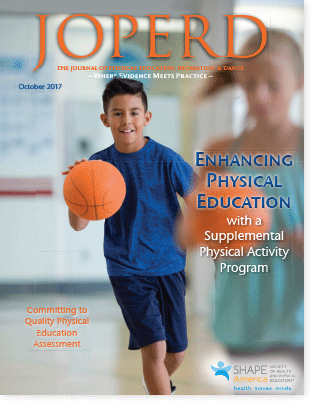 JOPERD Table of Contents
JOPERD Table of Contents
Enhancing Physical Education with a Supplemental Physical Activity Program
Megan Adkins, Matthew R. Bice, Kate Heelan, & James Ball

Schools have played a pivotal role in providing physical activity education to children. Elementary physical education has been the “go-to” class to enhance children’s motor skills and movement patterns; develop knowledge and skills about fitness and activity; apply concepts, principles and strategies to movement and performance; develop responsible personal and social behavior; and actively engage in physical activity while recognizing the value of being active for health, enjoyment and for oneself (SHAPE America – Society of Health and Physical Educators, 2014). Along with physical education, supplemental physical activity (PA) opportunities are commonly used in schools to increase activity time (e.g., recess, classroom PA breaks).
Over the past 25 years, for various reasons, many schools have reduced or eliminated recess and/or physical education time, thus decreasing the amount of physical activity provided daily to children. Decreased physical activity opportunities in schools have especially affected low-income community children who have low fundamental movement-pattern proficiency levels because of socio-environmental factors (de Vet, de Ridder, & de Wit, 2011; Vandendriessche, Vandorpe, Vaeyens, Malina, & Lefevre, 2012). A potential solution to increase physical activity time during the school day is to create additional opportunities for students to practice fundamental movement patterns. This may be accomplished through the development of a structured physical activity class taught during the school day in addition to physical education and recess.
This article describes a physical activity class implemented by researchers in three low socioeconomic schools in central Nebraska to supplement physical education. The goal of the physical activity class was to engage students in moderate-to-vigorous physical activity (MVPA) for at least 75 percent of the class time. The physical activity class was provided to students on days that physical education was not offered (two or three days per week). The pilot project was aimed at providing additional physical activity time to children classified as low-income in grades K–5 with a focus on fundamental movement-pattern development while enhancing minutes of MVPA.
To read the rest of this article,
click here to download a pdf.